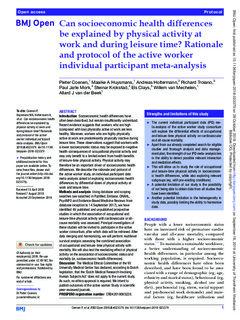| dc.description.abstract | People with a lower socioeconomic status have an increased risk of premature cardiovascular and all-cause mortality, compared with those with a higher socioeconomic status.1 2 To maintain a sustainable workforce, a better understanding of socioeconomic health differences, in particular among the working population, is required. Socioeconomic health differences have often been described, and have been found to be associated with a range of demographic (eg, age, ethnicity and marital status), behavioural (eg, physical activity, smoking, alcohol use and diet), psychosocial (eg, stress, social support and psychosocial work demands) and material factors (eg, healthcare utilisation and neighbourhood conditions).3–6 However, socioeconomic health differences remain poorly understood, as they cannot be fully attributed to these factors. A recent systematic review showed that psychosocial factors explain 4%–49%, behavioural factors 7%–45%, while material factors explain 11%–76% of health differences.7
To date, physical activity is considered an important and significant behaviour for the prevention of premature death from many lifestyle-related diseases.8 The health implications of engagement in different domains of physical activity (according to common PA research: leisure time, work, household and transport9) are considered to be positive and alike. Workers, who are physically active at work, most of them with low socioeconomic status, could therefore be expected to be healthier and live longer. Surprisingly, however, recent evidence suggests that workers who are highly physically active at work are less healthy and die earlier than those who are less physically active at work.10 11 This evidence shows a consistently reduced risk of lifestyle-related diseases associated with high doses of leisure-time physical activity, but an increased risk of cardiovascular diseases12–15 and mortality16–18 with high doses of occupational physical activity (even when adjusted for current health status, other lifestyle factors and socioeconomic status), suggesting a physical activity paradox.19 We have recently found evidence for this paradox in a systematic review, showing an increased risk of premature mortality among men who are highly physically active at work, compared with those who engage in low doses of occupational physical activity (HR; with 95% CI 1.18 (1.05 to 1.34)).20
Moreover, workers from lower socioeconomic status are often physically inactive during their leisure time,21 as these workers spend most of their daily physical activity time at work.22 The above suggests that workers with a lower socioeconomic status may be exposed to the negative health consequences of occupational physical activity and may only benefit to a limited extent from the positive health consequences of leisure-time physical activity. As such, the differential effects of physical activity at work and leisure time may be an important driver of socioeconomic health differences.23
To improve the health of workers with a lower socioeconomic status and to maintain a sustainable workforce, more knowledge on the opposing health effects of occupational and leisure-time physical activity is urgently required. Presently, a knowledge gap exists as to what type of interventions may work for whom and when. It is therefore important to identify workers who may benefit the most from physical activity interventions, to indicate what elements such interventions should consist of, and to identify barriers and facilitators of certain interventions. Such knowledge can inform physical activity-based interventions and public health guidelines, thus contributing to a reduction of socioeconomic health differences. An individual participant data (IPD) meta-analysis is essential to fill the knowledge gap indicated above. In contrast to a study-level meta-analysis, an IPD meta-analysis also allows for testing of interaction, mediation or moderation.24 This allows for the possibility of identifying relevant subgroups and the ability to test mechanistic pathways.25 26 Moreover, an IPD meta-analysis has the benefit of a larger number of data points, facilitating more statistically powerful and sound conclusions based on careful evaluation of modelling assumptions. An IPD meta-analysis also allows us to account for missing data at the individual participant level and to standardise analytical techniques, inclusion criteria and outcome definitions across studies.
In this manuscript, we describe the rationale and protocol of the active worker study, an IPD meta-analysis carried out by the active worker consortium. The primary aim of this study is to explore socioeconomic health differences related to physical activity at work and during leisure time. To do so, we will:
Assess the combined effect of occupational and leisure-time physical activity on cardiovascular and all-cause mortality.
Identify subgroups (eg, with pre-existing hypertension or obesity) that are particularly vulnerable for this effect.
Identify subgroups (eg, with high levels of cardiorespiratory fitness) that have a differential association between occupational and leisure-time physical activity and cardiovascular and all-cause mortality.
Assess the independent contribution of occupational and leisure-time physical activity to socioeconomic health differences. | nb_NO |
| dc.description.localcode | Copyright information: © Author(s) (or their employer(s)) 2018. Re-use permitted under CC BY-NC. No commercial re-use. See rights and permissions. Published by BMJ. This is an open access article distributed in accordance with the Creative Commons Attribution Non Commercial (CC BY-NC 4.0) license, which permits others to distribute, remix, adapt, build upon this work non-commercially, and license their derivative works on different terms, provided the original work is properly cited, appropriate credit is given, any changes made indicated, and the use is non-commercial. | nb_NO |

